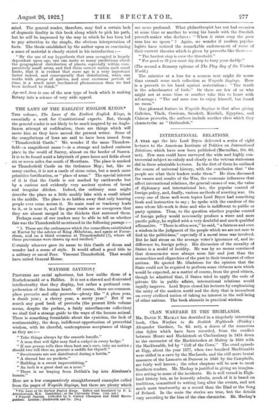essentially a work for Constitutional experts. But, though the general
reader is not likely to be much inspired by an Anglo- Saxon attempt at codification, there are things which will move him as they have moved the present writer. Some of the compilations of laws are said to have been issued from " Thundersfield Castle." We wonder if the same Thunders- field—a magnificent name a strange and indeed ominous place in the weald of Surrey, almost on the border of Sussex. It is to be found amid a labyrinth of grass lanes and fields about , six or seven miles due south of Merstham. The place is marked as Thunderfield Castle on the Ordnance Map ; but, like so many castles, it is not a castle of stone ruins, but a much more primitive fortification, or "place of arms." The special interest of it is that the Castle is not marked by earthworks but by a curious and evidently very ancient system of broad and irregular ditches. Indeed, the ordinary man might describe the place as a little muddy lake with a small island in the middle. The place is so hidden away that only hunting people ever come across it. No main road or trackway leads to it, or is near it, and the grass roads are so overgrown that they are almost merged in the thickets that surround them.
Perhaps some of our readers may be able to tell us whether this was the Thundersfield mentioned in the following passage :— " 1. These are the ordinances which the councillors established at Exeter by the advice of King /Ethelstan, and again at Faver- sham, and on a third occasion at Thundersfield (?), where all these provisions were drawn up and ratified."
Certainly whoever gave its name to this Castle of doom and wonder had a sense of style. It would afford a good title to a military or naval Peer. Viscount Thunderfield. That would have suited General Home.


































 Previous page
Previous page